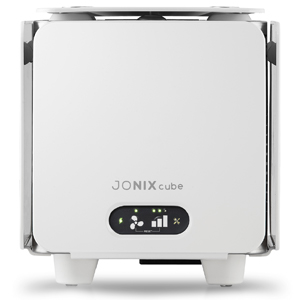3 patents to protect people

One of the questions we are most often asked is whether our sanitation devices use, produce or release ozone.
The question is actually legitimate and also stems from a confusion between sanitation technologies such as ionisation and ozonisation, which are very different from each other, for "raw material", effects, consequences and use.
What is ozone?
Difference between ionisers and ozonisers
What is ozone?
Do Jonix cold plasma purifiers produce ozone?
What is ozone?
Ozone is a gas composed of 3 oxygen atoms. To be clear, normal oxygen molecules (O2), those we breathe, have two oxygen atoms. This third atom makes ozone very unstable, highly susceptible to chemical reaction with other substances and, at certain concentrations, capable of killing micro-organisms and particular odours.
Ozone decomposes spontaneously in the presence of oxidizable materials, moisture and solid surfaces.
Ozone occurs naturally in the atmosphere: it is formed in the stratosphere when, under the influence of sunlight, oxygen molecules (O2) break down and reform into ozone molecules (O3).
Commonly referred to as "good ozone", stratospheric ozone protects people, trees, crops, property and micro-organisms from the harmful effects of the sun's ultraviolet radiation. This beneficial ozone is, however, partially destroyed by man-made chemicals, resulting in the so-called "ozone hole".
Ground-level ozone, on the other hand, is generated by chemical reactions between nitrogen oxides (NOx) and volatile organic compounds (VOCs). This occurs when pollutants emitted by cars, power plants, industrial boilers, refineries, chemical plants and other sources react chemically in the presence of sunlight.
Ozone is most likely to reach unhealthy levels on hot, sunny days in urban environments, but may still be present in colder months. Airborne ozone pollution, when in high concentrations, is harmful to human and ecosystem health in general, causing respiratory and lung problems and damaging sensitive vegetation during the growing season.
Difference between ionisers and ozonisers
Ozonators are machines built to produce only ozone with the aim of exploiting its oxidising capacity to decontaminate environments. It is important to know that, in order to be able to eliminate micro-organisms and be effective, ozone must be in such a concentration that it is also harmful to human health.
Sanitation of working environments with ozone must be done in the absence of people, using a dose and time of use sufficient to kill micro-organisms and viruses but with minimal deterioration effects on materials. It is known that environmental concentrations of ozone acceptable for human health may not be sufficiently effective as sanitizers (Source: Professional use of ozone also in reference to COVID-19 - ISS-INAIL Working Group).
For this reason, high-concentration ozonators cannot be left running permanently and in the presence of people.
Units using Jonix Non Thermal Plasma technology use an advanced form of ionisation to decontaminate air and surfaces.
Ionisation is a natural air purification system that occurs under specific atmospheric conditions, for example during a thunderstorm. In these cases, the electrical discharge of lightning releases electrically charged particles: electrons, ions, atoms and molecules which, on colliding with each other, produce oxidising species capable of attacking and dissolving pollutants in the air.
In the Jonix devices, sanitisation is carried out by means of a non-thermal plasma: thanks to appropriate patented actuators, a cold plasma is generated, i.e. a plasma at room temperature (quite different from the one that takes place, for example, on the sun, which is rather a thermal plasma).
This cold plasma ionises the air that comes into contact with the actuators: the molecules that make up the air are thus "activated" because they are "fragmented" into reactive species (electrons, radical species, ions, etc.); these reactive species produce numerous chemical and physical processes, including the oxidation and degradation of polluting molecules and micro-organisms dispersed in the air and on surfaces.
The advanced ionization of Jonix devices is a sanitation system that, unlike ozonization, can be used continuously and for a long period of time, in the presence of people, without side effects, following the optimal sizing indications of the device. Thanks to the non-thermal plasma of Jonix, the environments (air and surfaces) are continuously decontaminated, even in the presence and passage of people.
Do Jonix cold plasma purifiers produce ozone?

JONIX devices use non-thermal plasma technology to generate reactive oxidising species, which function to sanitise and decontaminate air and surfaces.
JONIX has developed 3 patents to protect the specificity of its Non-Thermal Plasma generators: indeed, these elements use voltages and frequencies that minimise ozone production.
Compared to ozonators, whose geometry and power supply are designed and managed to maximise ozone production, Jonix generators pursue the opposite objective, namely to limit the concentration of ozone compared to other species. For Jonix units, ozone production is therefore a secondary aspect, deliberately kept to a minimum and always well below the parameters indicated in the standard (50 ppb - WHO 2005 & IEC 60335-2-65 standard).
In addition, as with any sanitation or biological or chemical species removal device, it is important to consider the size and time of use according to the volume to be treated and the pollutant load.
In short: JONIX units, if correctly positioned and sized in relation to the volume of the room to be treated, allow ozone concentrations in the environment to be achieved below the strictest limits recommended by international directives.
Tests and Certifications
Our purifiers destroy the Coronavirus
What equipment is needed to purify the air?
> Ozone and cold plasma: Let's clarify
 Youtube
Youtube  LinkedIn
LinkedIn